Cream soap tutorial
Safety in the first place
- Prepare your workplace and keep it organize.
- Educate your family and special care with young children.
- Be sure you understand the process.
- Wear rubber gloves and safety glasses.
- Never leave the hot oil unattended.
- Never leave the soda and soda solution unassisted.
- Work with method.
- Do not get distracted at work.
- Clean up spills immediately.
Formula
This form was developed using the calculator Cream Soap Calculator authored by Kathleen Koch, which is an Excel spreadsheet with macros, which can be purchased for $ 9.95 at this site:
http://www.soulgazersundries.com/calculator.html
From the viewpoint of the components in oils, is a conventional approach. Shea butter provides moisturizing and hydrating properties. The use of stearic acid, a fatty acid (C18) saturated, provides a dense and persistent foam, suitable for a shaving cream, as was originally the goal of the formulation.
The creaminess is achieved with a ratio of Potassium Hydroxide: Sodium Hydroxide, being here used a 5:1 ratio, noting that the results in hard soap is due to lye and potash in liquid soap. Another factor to creaminess is the degree of aeration which is obtained by the use of electric mixer for kitchen and quantity of dilution water.
Once fixed relationship lye / potash, the hardness of the soap, as is more or pasty, creamy, is achieved with a quantity of liquid, water or another component such as Aloe vera juice. It is a matter of experimentation.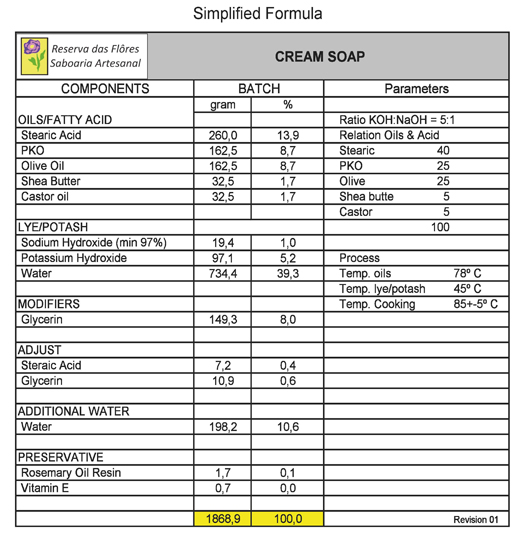
This formula is a simplified summary of the formula generated by the calculator, more practical to use.
Equipments
The safety equipment, goggles and gloves are essential and should always be used in handling of raw materials and the process.
In this process is used a slow-cooker “crock pot” to perform the saponification reaction, which is a hot process “hot process”. This pan allows a more controlled, clean and safe. It could be used a system of double boiler or a furnace or electric gas alternatives. The characteristic heating the pan Narita NSC-35 that was used in this tutorial is seen below.
It is essential to use an electric mixer kitchen preferably global, to phase aeration soap. This phase is very labor intensive aeration and sometimes requires a pretty powerful mixer, as it was used at one point in this tutorial. If the goal is to make a shaving cream or shaving soap, a modest mixer can do the job.
Heating caracteristics
As can be seen, it is a slow heating cooker whose maximum temperature is reached in 180 min and not exceeding 85°C in regulating high.
Preparing the ingredients
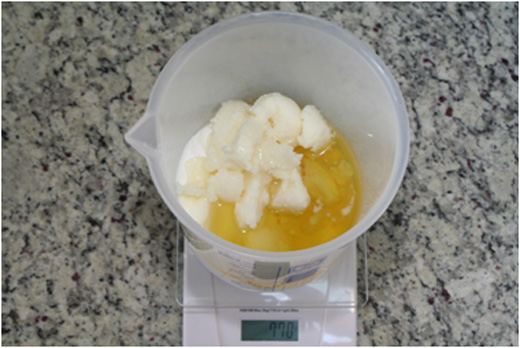 All oils and shea butter ready to be melted.
All oils and shea butter ready to be melted.
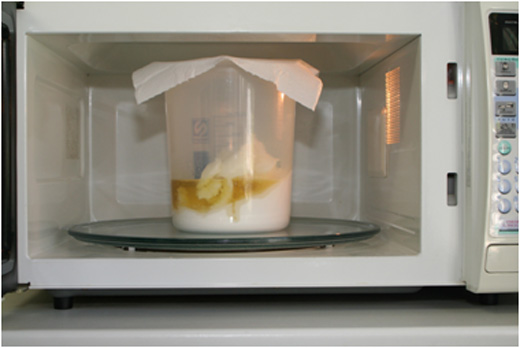 Melt in the microwave on high for 2 min.
Melt in the microwave on high for 2 min.
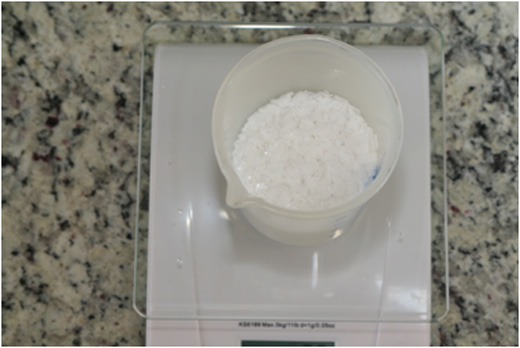 Weigh potassium hydroxide (potash) and sodium hydroxide (lye).
Weigh potassium hydroxide (potash) and sodium hydroxide (lye).
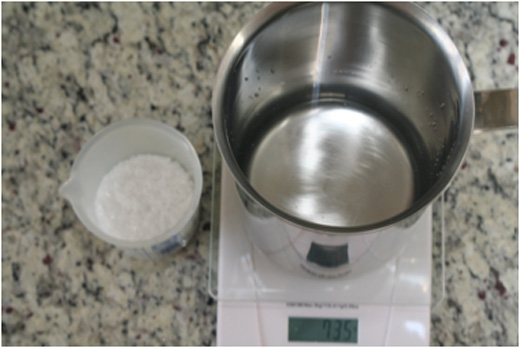 Weigh the water solution of alkali.
Weigh the water solution of alkali.
The solution of alkali it always be done by adding the alkali on the water and never the other way to avoid a situation of accidents. The solution left at 45°C.
The oil mixture must be 79°C approximately.
Process
Place the mixture of oils in the slow-cooker.
Slowly add the mixture of alkali with manual stirring with the mixer.
Turn the mixer and stir.
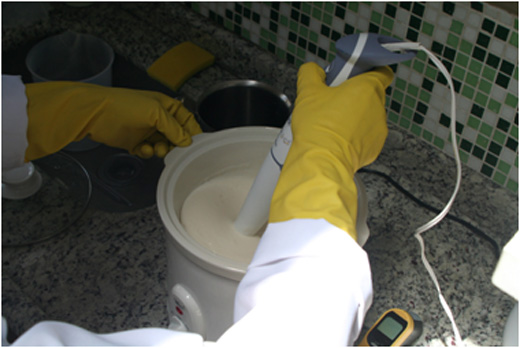 Stir with mixer until the beginning of the formation of trace.
Stir with mixer until the beginning of the formation of trace.
Formed the trace remove the mixer.
There is a phase viscosity drop here and get cooking. Place the lid.
After 1 hour of cooking. If trend outburst, remove the lid and stir with a spatula. Always try to keep the lid so there is no loss of temperature.
After 2 hours of cooking. The temperature should be around 88°C.
After 3 hours of cooking starts the formation of the gel aspect.
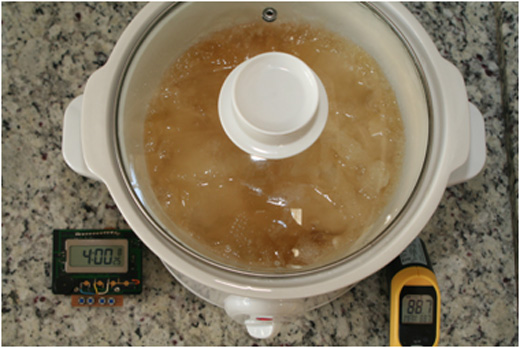 After 4 hours it is time to check the saponification reaction, if is now complete.
After 4 hours it is time to check the saponification reaction, if is now complete.
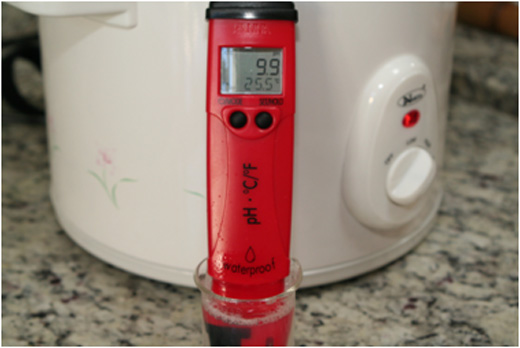 Take a sample diluted in hot water and measure the pH when cold. We used a portable digital pHmeter but is possible to use pH indicator paper. At pH 9.9 the reaction is complete.
Take a sample diluted in hot water and measure the pH when cold. We used a portable digital pHmeter but is possible to use pH indicator paper. At pH 9.9 the reaction is complete.
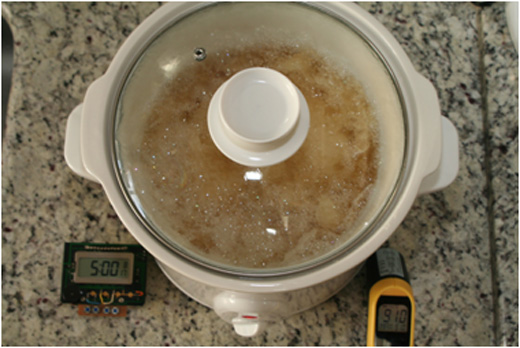 After 5 hours there is not still a translucent gel formation.
After 5 hours there is not still a translucent gel formation.
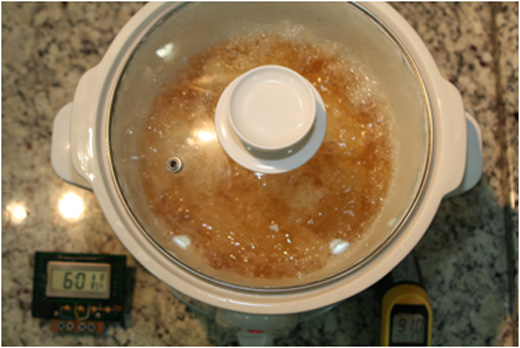 Finally, after 6 hours the gel is a translucent appearance.
Finally, after 6 hours the gel is a translucent appearance.
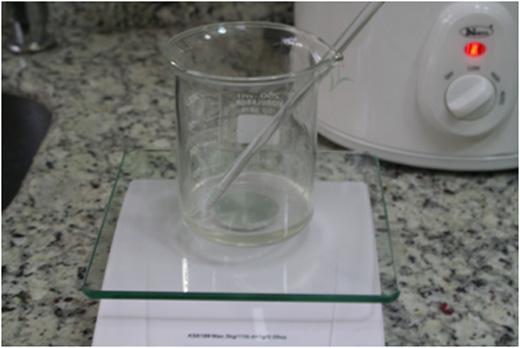 Prepare the adjuster part, stearic acid dissolving in hot glycerin.
Prepare the adjuster part, stearic acid dissolving in hot glycerin.
Add the mixture of glycerin and stearic acid and mix well. Cooking for another half hour.
Off the pan, cover, and let stand for 18 hours (overnight).
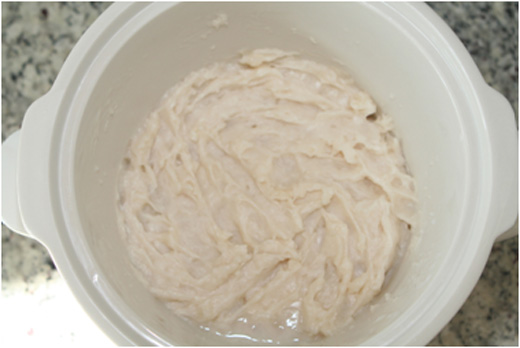 After resting it is the aspect of soap mass.
After resting it is the aspect of soap mass.
It is a very thick mass difficult to mix.
Prepare water adjustment. Weigh and record the amount to get the weight at the end and so the more exact formula. Can be used as other liquid aloe vera juice instead of water.
Weigh preservatives / natural antioxidants. It is difficult to get Vitamin E and rosemary oleoresin in Brazil. This was bought in the U.S. (larger bottles) and the other in Australia.
Add the natural preservatives, and try to stirr.
Put water adjustment gradually.
The best way of mix the soap mass and homogenize is using your hands with gloves for hygiene reason.
With hands after homogenize well, make balls. These balls will facilitate the aeration process.
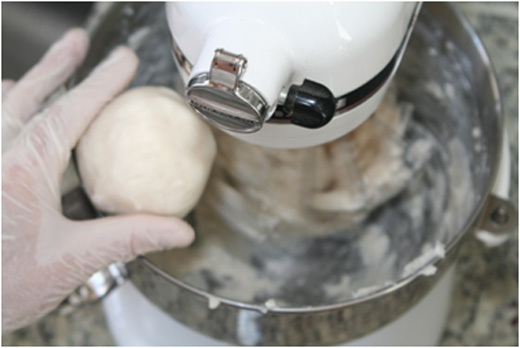 Using an electric planetary mixer go putting the balls one at a time in blender.
Using an electric planetary mixer go putting the balls one at a time in blender.
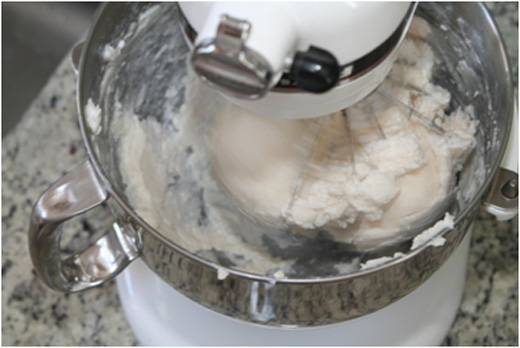 This aeration process is very hard, requires a lot of mixer power.
This aeration process is very hard, requires a lot of mixer power.
Here is almost good, looks cream.
Ready the aeration process.
Place the puff pastry into a container with a lid and let stand for a week.
Colors and Fragances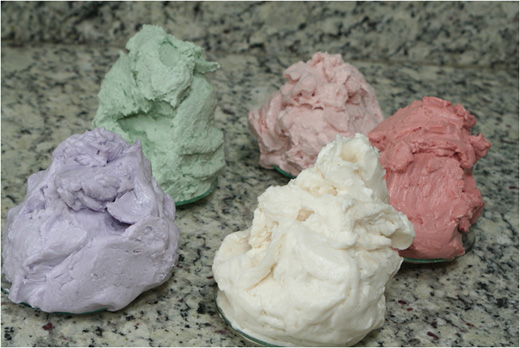
After a week of rest of the puff pastry was made 4 different types of soap cream: Dreams (pink), Lavender (violet), Silvestre (green) and Terracotta (red) and 1 Wood shaving cream (white, no color ). In all were added Amazon oils: Andiroba, Copaiba and Cupuaçú. Since this tutorial was submitted to a forum on the subject in the U.S., these oils was placed to honor our typical richness and diversity.
The table below shows the composition of each type made:
As the process is repeated only show a process of adding color and fragrance.
Preparing Amazon oils
Weigh the oils of the Amazon Andiroba, capoaíba and cupuaçu.
As oil cupuaçu soft solid at room temperature, melt it in the microwave.
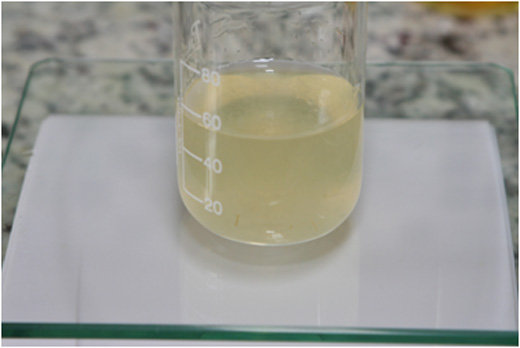 Here I used the Aloe vera juice as liquid to adjust the consistency.
Here I used the Aloe vera juice as liquid to adjust the consistency.
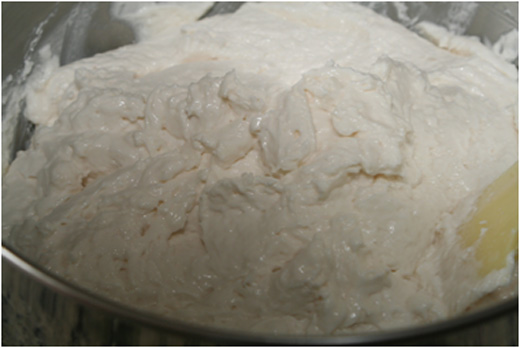 Adjust the consistency with Aloe vera, iusing the mixer.
Adjust the consistency with Aloe vera, iusing the mixer.
Lavender soap cream preparation
Weigh the pigment ultramarine violet.
Disperse the pigment in a little cupuaçu oil. The pigment must be well dispersed to obtain a uniform color.
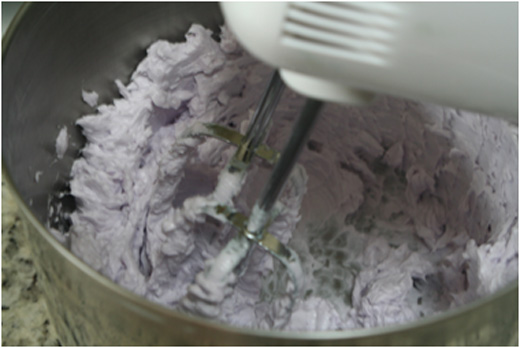 Mix in blender to homogenize the color of the soap.
Mix in blender to homogenize the color of the soap.
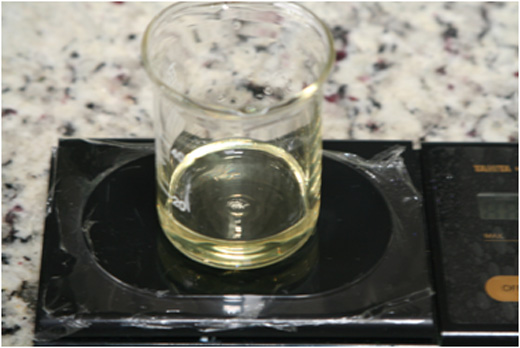 Weigh the essential oils of lavender mont blanc and litsea cubeba.
Weigh the essential oils of lavender mont blanc and litsea cubeba.
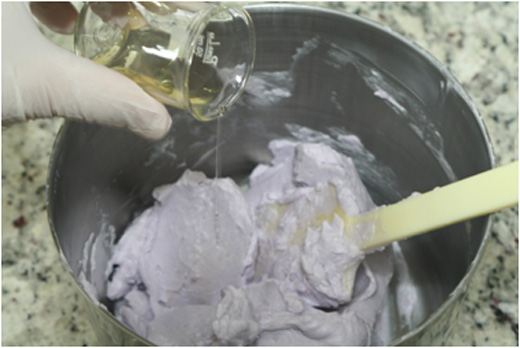 Add the mixture of essential oils.
Add the mixture of essential oils.
Stir to mix well in mixer.
Here is the lavender cream soap ready!
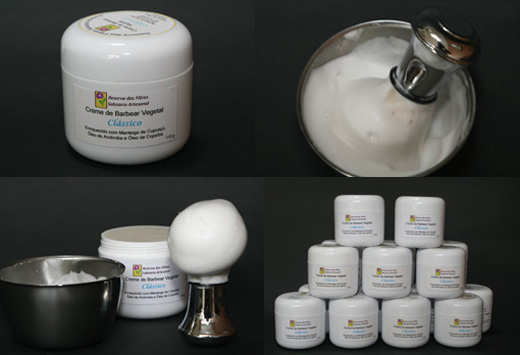 Persistent and dense foam, moisturizing properties of olive oil, shea and cupuaçu and healing, bactericidal by the presence of Amazon oils: Andiroba and Copaiba.
Persistent and dense foam, moisturizing properties of olive oil, shea and cupuaçu and healing, bactericidal by the presence of Amazon oils: Andiroba and Copaiba.
Thanks

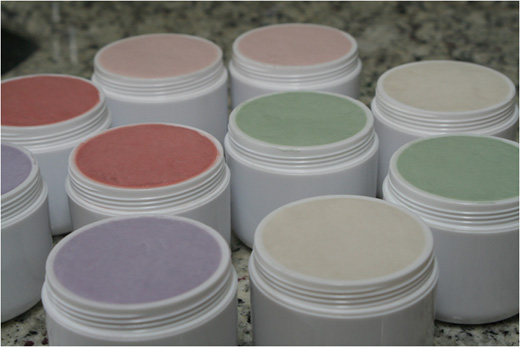
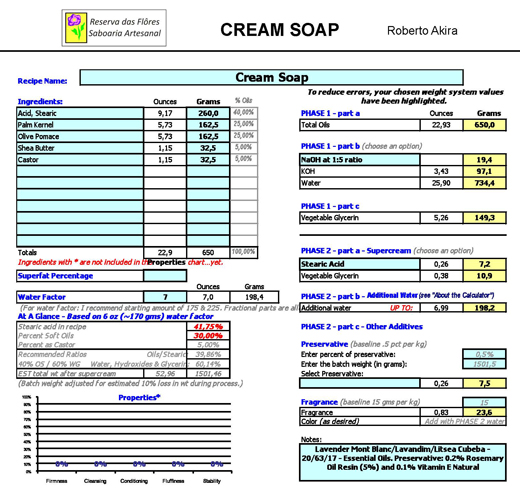
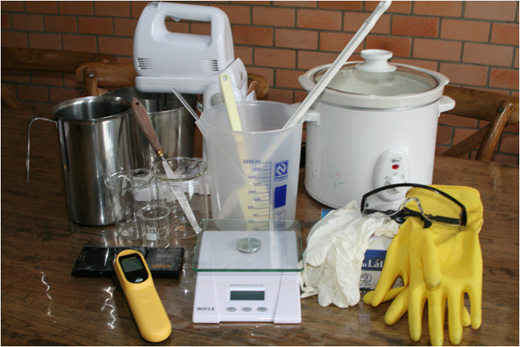
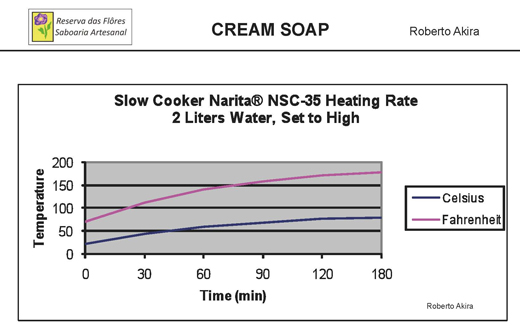
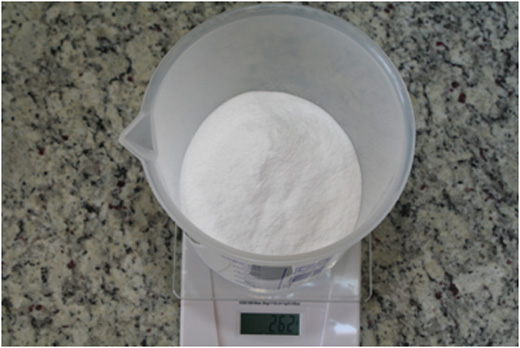
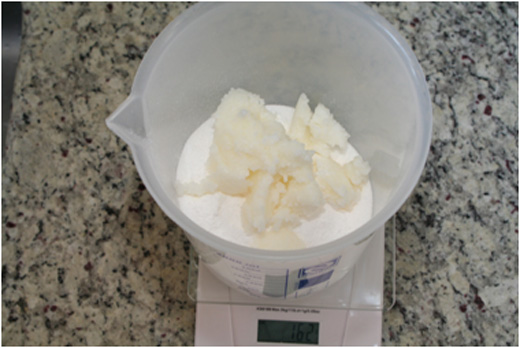
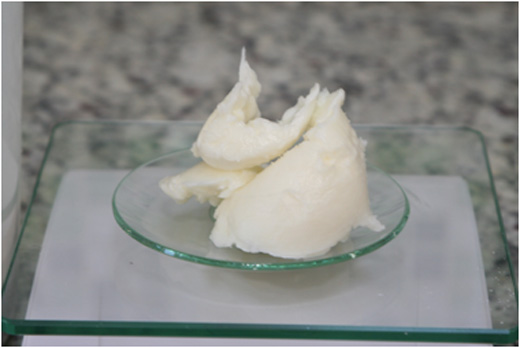
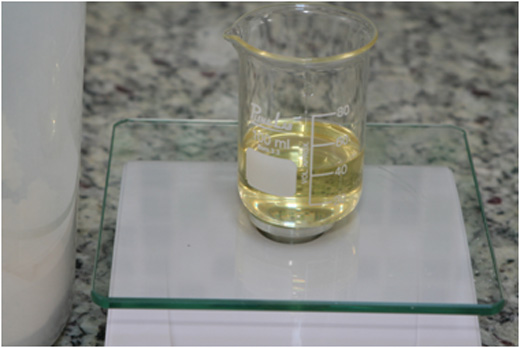
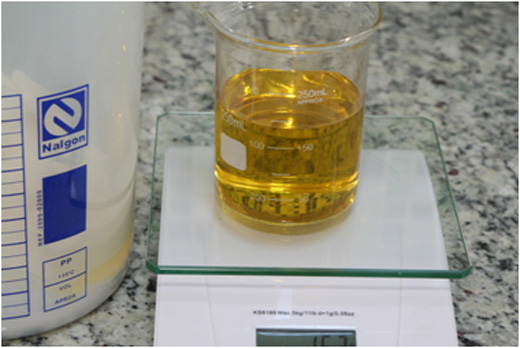
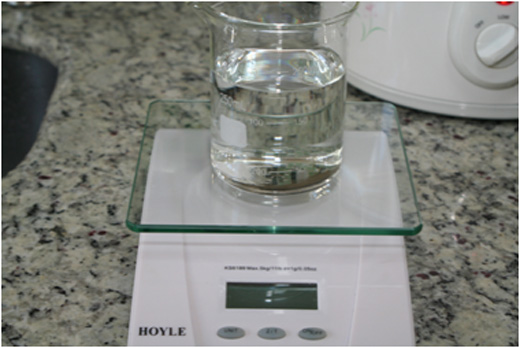
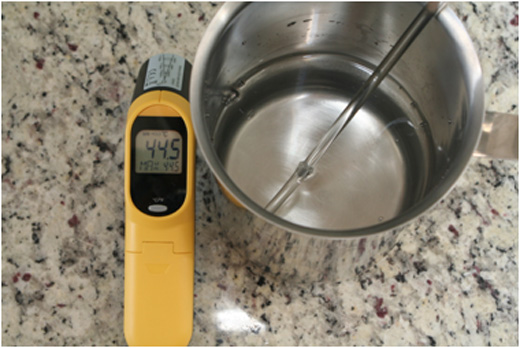
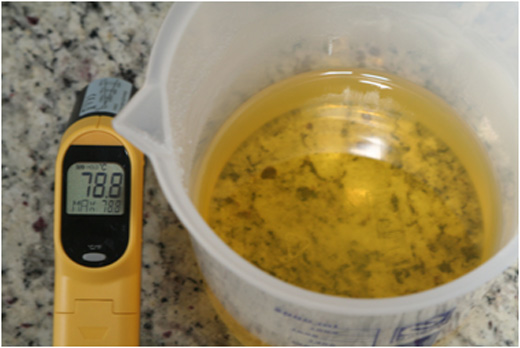
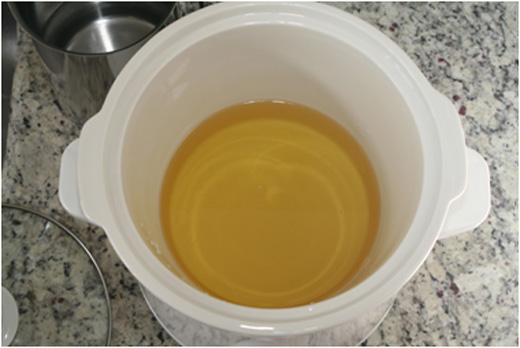
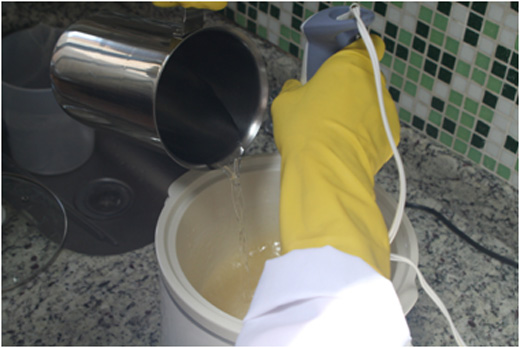
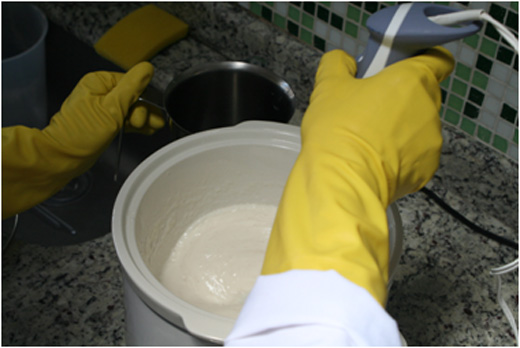
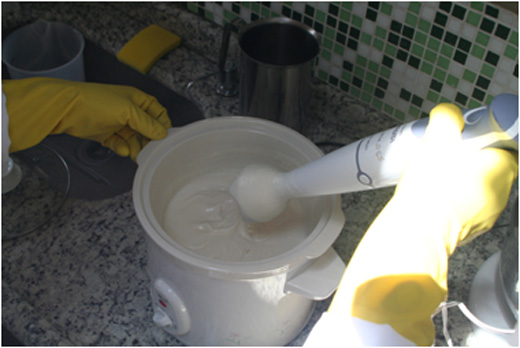
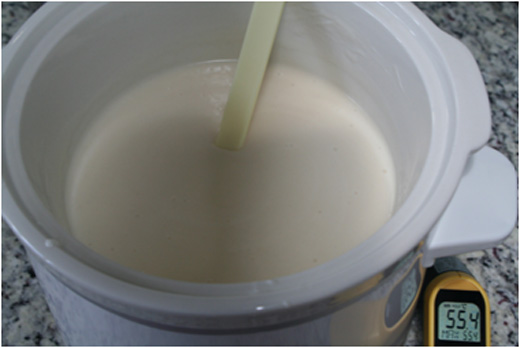
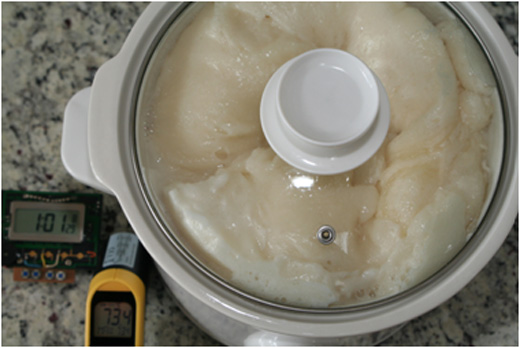
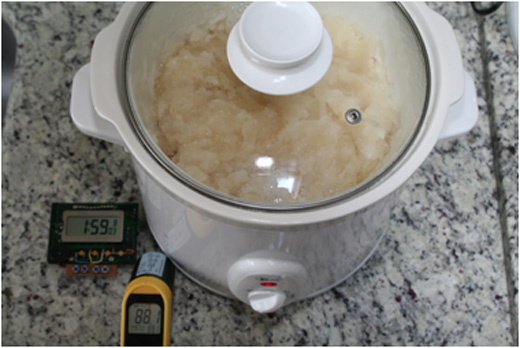
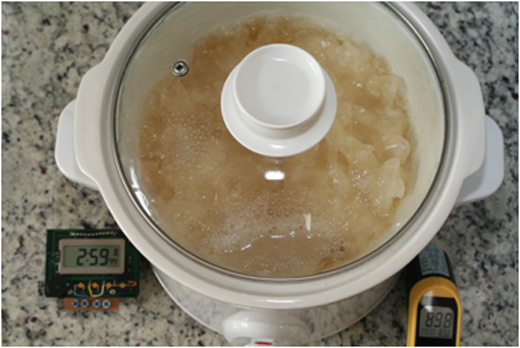
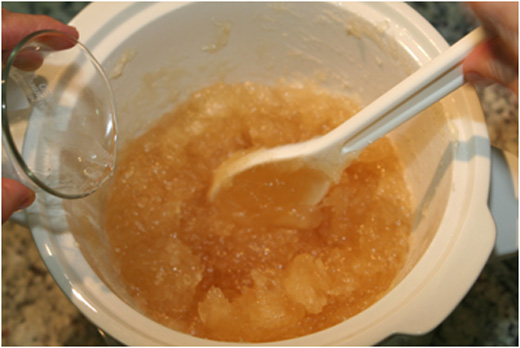
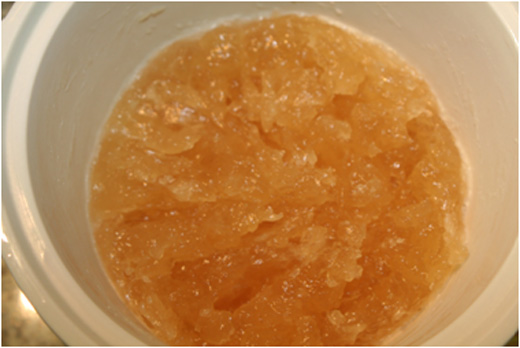
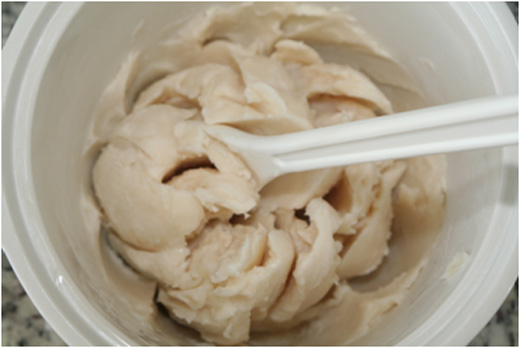
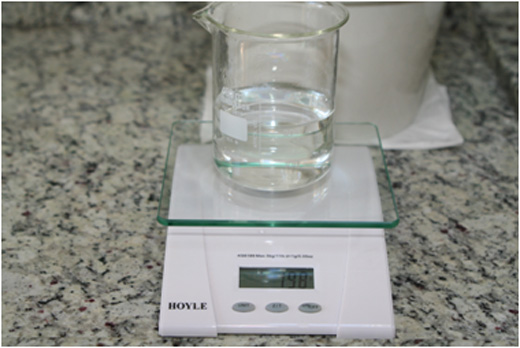
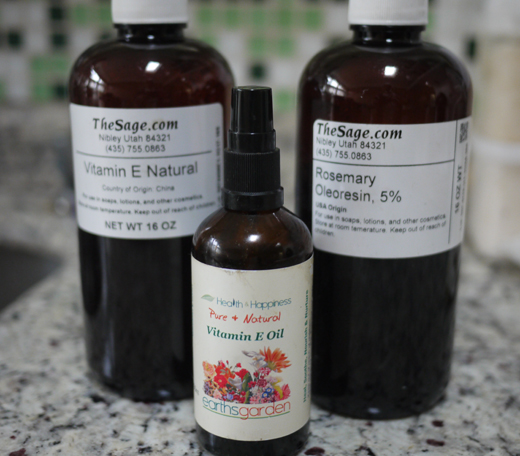
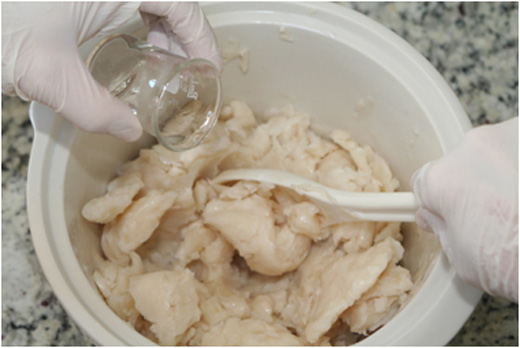
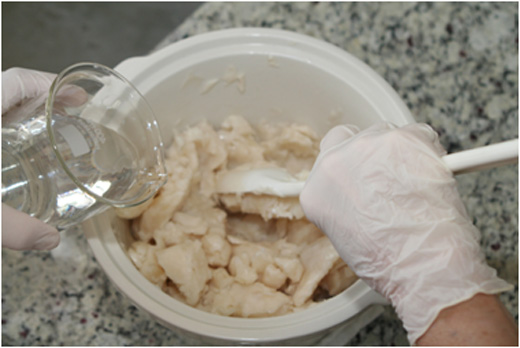
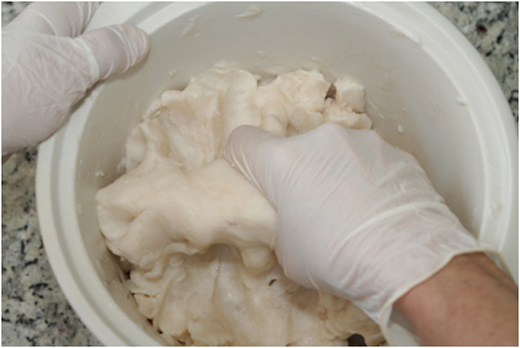
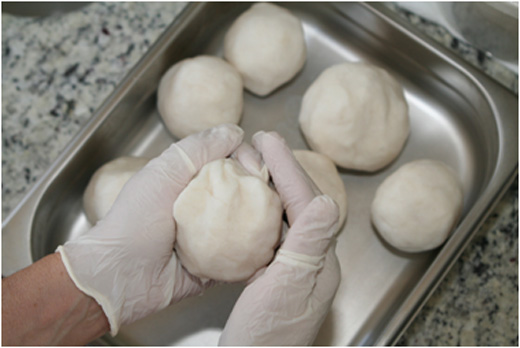
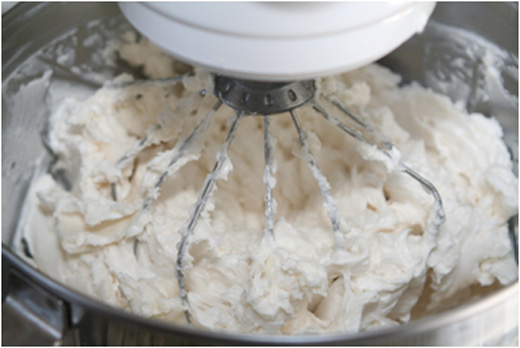
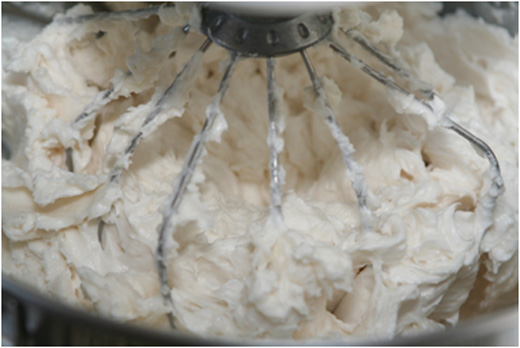
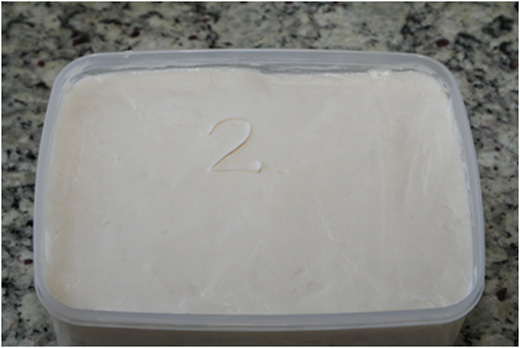
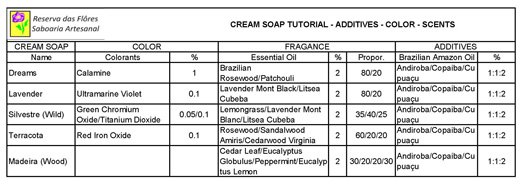
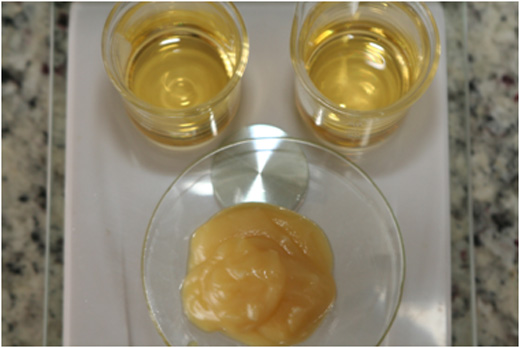
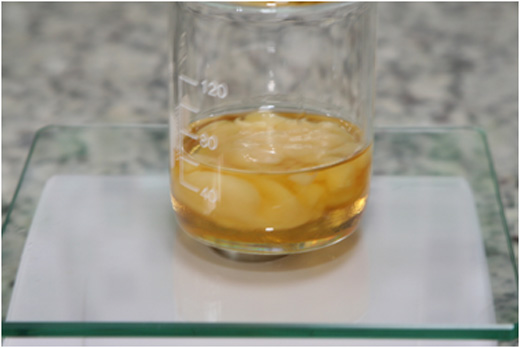
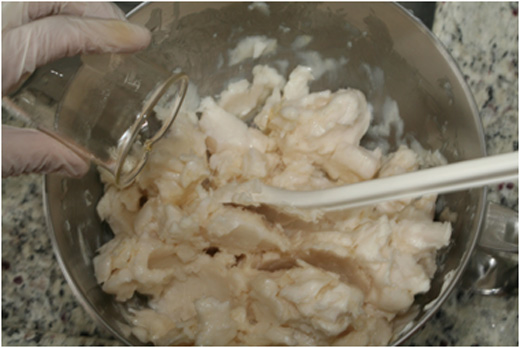
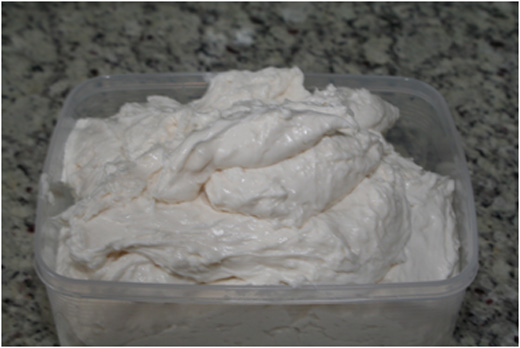
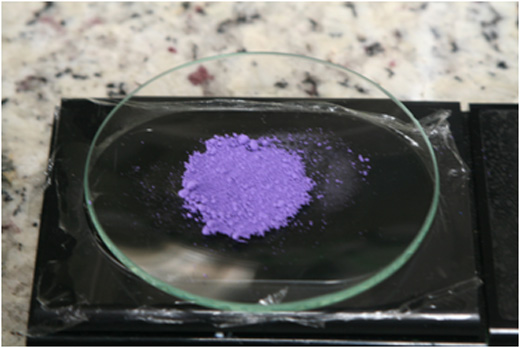
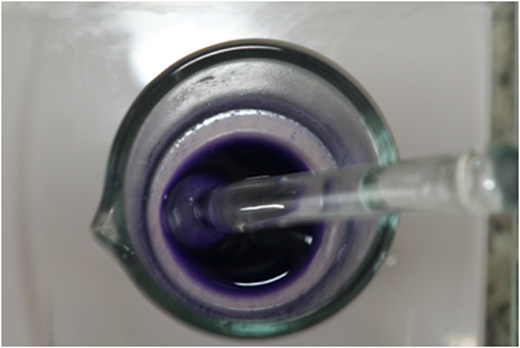
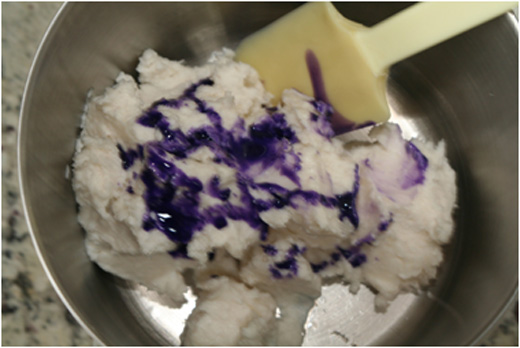
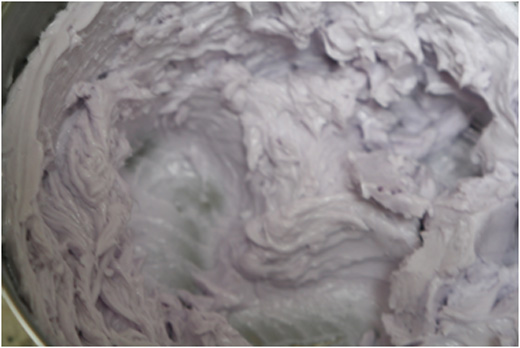
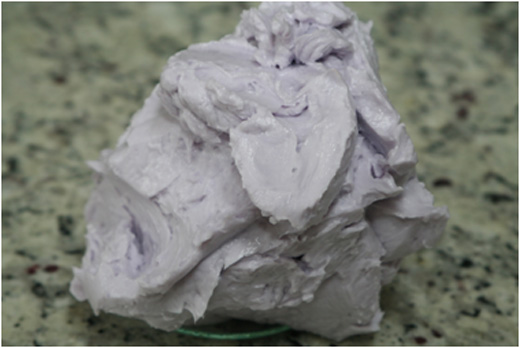







I would like to learn more about the Brazilian oils. If you have any links that you have found educational, I’d appreciate them.
I currently use Andiroba oil as a natural bug repellent and also treating a sprained ankle with it. Also have a friend who uses it for arthritis.
Thank you for all that you share. I will attempt to make this cream soap at some point this year.
Namaste,
Colleen
Hi Colleen,
Nice to hear again!
Look that: http://www.amazonoil.com.br/en/index.htm
Sorry, another question. I was looking for Capoaiba oil and all I can find is Copaiba essential oil (Copaifera officinalis) from Brazil. Are these one and the same?
Thanks in advance for your help.
Colleen
Hi Colleen
There is one unique copaiba oil resin, that is extract from Copaifera spp., Leguminosae – Caesalpinoideae).
See here: http://www.rain-tree.com/copaiba.htm#.UsmXA376lEU
Thank you for your continued support!! Greatly appreciated.
Colleen,
Thanks a lot!